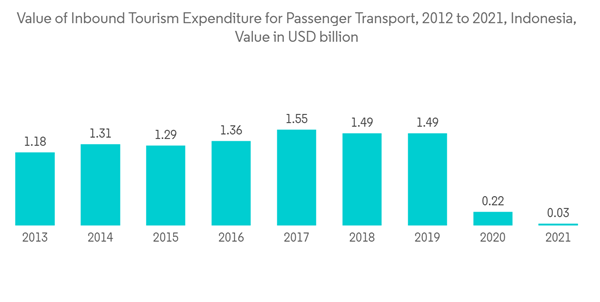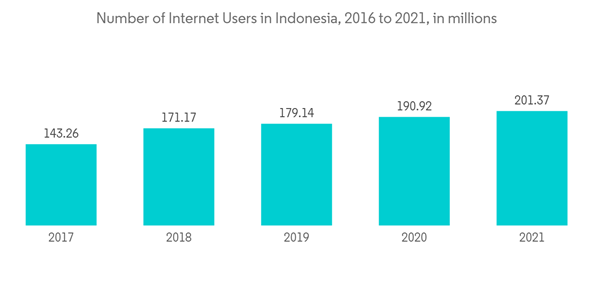The Indonesia Ride Hailing Market is valued at USD 2.67 Billion and expected to surpass a net valuation of USD 4.66 Billion, registering a solid CAGR growth of 8.75% during the forecast period.
The outbreak of COVID-19 has deeply impacted the business of Ride-Hailing in Indonesia owing to strict lockdowns prevailing across all the nations of the globe, which restricted tourists from visiting the country. Soon After Q2 2022, people again started to visit Indonesia for tourism purposes, helping the ride-hailing businesses regain their recovery.
The number of foreign tourists arriving has increased significantly, according to the Indonesian Ministry of Tourism and Creative Economy. 2.27 million foreign visitors came to Indonesia from January through September, an increase of more than 2,500 percent. The increase from the same time in 2021 was 2,530.58%. There were 538,320 visits in September alone, an increase of 10,768.46 percent over September 2021.
The market is attracting impressive investment over the online sales channel, which is slowly picking up an upward trend. Moreover, with rising internet and smartphone penetration, online booking has been witnessing a positive growth outlook. A similar scenario is anticipated to register over the forecast period. Moreover, the electric vehicle fleets in the country are expected to grow in the coming years, which will also encourage the ride-hailing services offered across the country to attract customers and curb greenhouse emissions.
Considering these aspects, demand for Indonesian ride-hailing is expected to remain on the higher side of the graph during the forecast period.
The Indonesian government has made various changes to the national tourism sector management as a result of the negative impacts of the COVID-19 outbreak. The Ministry of Tourism and Creative Economy aims to attract 1.8-3.6 million international visitors and 260-280 million domestic visitors and generate foreign exchange revenues from the tourism sector of USD 470 to USD 1.7 billion in 2022. Additionally, the government hopes to increase the sector's share of the GDP to 4.3 percent in 2022.
The Ministry of Tourism and the Creative Economy of Indonesia invests in the country's tourism industry to foster sustainable and community-based tourism. Five super-priority tourism destinations, eight special economic zones, and 12 sustainable tourism projects are expected to benefit from the investments, which will increase demand for car rental services in the coming years.
Moreover, considering these factors, key ride-hailing companies in Indonesia are looking forward to capitalizing on the same to resonate better prominence in the business. This has elevated the overall demand for ride-hailing services in the market.
In addition, it provides additional facilities to monitor a vehicle’s operation, performance, and maintenance in real-time. Such features are tremendous assets for drivers and fleet managers, enabling them to better and more efficiently identify risks and implement timely improvements to their ride-hailing services.
Online vehicle bookings are increasing in the country due to the rising usage of smartphones, and the growth in the number of users preferring online channels. Indonesia is the epi-center for the tourist spots where millions of tourists visit each, these online booking platforms help them in maintaining the accessibility of the fleet and improve connectivity.
Most consumers prefer hailing vehicles online during peak seasons. As the vehicle-hailing market experiences an increase in demand during peak holiday seasons, people tend to book vehicles in advance. Only a handful of vehicles are booked through rental stores, mostly during the off-season. Online booking services include booking cars via internet sites and mobile applications, among which booking-via-sites is the most common method opted for by consumers.
Moreover, with ongoing demand and post recover from COVID-19, demand for vehicle hailing has quickly taken pace across the country. This opportunity has been addressed by several companies operating in the region who are looking forward to capitalizing on the same.
Moreover, the ride-hailing providers in Indonesia have strategically shifted their brand’s direction by placing their utmost importance on the quality and safety of passengers and vehicles, owing and hailing the vehicle, followed by other features.
This product will be delivered within 2 business days.
The outbreak of COVID-19 has deeply impacted the business of Ride-Hailing in Indonesia owing to strict lockdowns prevailing across all the nations of the globe, which restricted tourists from visiting the country. Soon After Q2 2022, people again started to visit Indonesia for tourism purposes, helping the ride-hailing businesses regain their recovery.
The number of foreign tourists arriving has increased significantly, according to the Indonesian Ministry of Tourism and Creative Economy. 2.27 million foreign visitors came to Indonesia from January through September, an increase of more than 2,500 percent. The increase from the same time in 2021 was 2,530.58%. There were 538,320 visits in September alone, an increase of 10,768.46 percent over September 2021.
The market is attracting impressive investment over the online sales channel, which is slowly picking up an upward trend. Moreover, with rising internet and smartphone penetration, online booking has been witnessing a positive growth outlook. A similar scenario is anticipated to register over the forecast period. Moreover, the electric vehicle fleets in the country are expected to grow in the coming years, which will also encourage the ride-hailing services offered across the country to attract customers and curb greenhouse emissions.
Considering these aspects, demand for Indonesian ride-hailing is expected to remain on the higher side of the graph during the forecast period.
Indonesia Ride Hailing Market Trends
Rise in Tourism Activities to Positively Drive the Market
Indonesia is the largest archipelago in the world, ranging from Sabang in Aceh to Merauke in Papua, which is made up of thousands of large and small islands which are connected by the strait and sea making it the perfect place for tourism. The Indonesian government aggressively promotes tourism globally to achieve 10+ million inbound tourists per year to make it the biggest tourism market.The Indonesian government has made various changes to the national tourism sector management as a result of the negative impacts of the COVID-19 outbreak. The Ministry of Tourism and Creative Economy aims to attract 1.8-3.6 million international visitors and 260-280 million domestic visitors and generate foreign exchange revenues from the tourism sector of USD 470 to USD 1.7 billion in 2022. Additionally, the government hopes to increase the sector's share of the GDP to 4.3 percent in 2022.
The Ministry of Tourism and the Creative Economy of Indonesia invests in the country's tourism industry to foster sustainable and community-based tourism. Five super-priority tourism destinations, eight special economic zones, and 12 sustainable tourism projects are expected to benefit from the investments, which will increase demand for car rental services in the coming years.
Moreover, considering these factors, key ride-hailing companies in Indonesia are looking forward to capitalizing on the same to resonate better prominence in the business. This has elevated the overall demand for ride-hailing services in the market.
Rising Smartphones and Internet Penetration Opening New Avenues
With smartphone adoption alongside the rising population of Indonesia, people have quickly shifted their respective stances towards hailing online cars. In addition, tourists and local people have been also identified as option channels for ride-hailing. In 2021, the number of internet users witnessed around 77.1% of the total country’s population, which is likely to grow to 93.2% of the total country’s population by 2030. Similarly, during the same period, the number of smartphone users in the country witnessed around 199.18 Million which is likely to witness major growth for the online ride-hailing service.In addition, it provides additional facilities to monitor a vehicle’s operation, performance, and maintenance in real-time. Such features are tremendous assets for drivers and fleet managers, enabling them to better and more efficiently identify risks and implement timely improvements to their ride-hailing services.
Online vehicle bookings are increasing in the country due to the rising usage of smartphones, and the growth in the number of users preferring online channels. Indonesia is the epi-center for the tourist spots where millions of tourists visit each, these online booking platforms help them in maintaining the accessibility of the fleet and improve connectivity.
Most consumers prefer hailing vehicles online during peak seasons. As the vehicle-hailing market experiences an increase in demand during peak holiday seasons, people tend to book vehicles in advance. Only a handful of vehicles are booked through rental stores, mostly during the off-season. Online booking services include booking cars via internet sites and mobile applications, among which booking-via-sites is the most common method opted for by consumers.
Moreover, with ongoing demand and post recover from COVID-19, demand for vehicle hailing has quickly taken pace across the country. This opportunity has been addressed by several companies operating in the region who are looking forward to capitalizing on the same.
Indonesia Ride Hailing Market Competitor Analysis
The market is moderately fragmented as the players in the respective country have a high market share compared to the overall region. UBER, Grab, Gojek, and others have a prominent share in Indonesia Ride-Hailing Market.Moreover, the ride-hailing providers in Indonesia have strategically shifted their brand’s direction by placing their utmost importance on the quality and safety of passengers and vehicles, owing and hailing the vehicle, followed by other features.
Additional benefits of purchasing the report:
- The market estimate (ME) sheet in Excel format
- 3 months of analyst support
This product will be delivered within 2 business days.
Table of Contents
1 INTRODUCTION
4 MARKET DYNAMICS
5 MARKET SEGMENTATION (Market Size in Value USD Billion)
6 COMPETITIVE LANDSCAPE
Companies Mentioned (Partial List)
A selection of companies mentioned in this report includes, but is not limited to:
- Uber Technologies Inc.
- Grab Holdings Inc.
- PT Gojek
- Traveloka
- Adi Sarana Armada Tbk
- ANI Technologies Pvt. Ltd
- PT Indonesia AirAsia
Methodology

LOADING...










